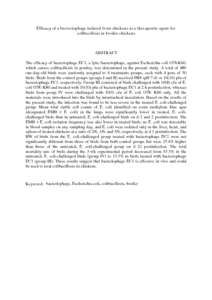Citation
Lau, Gee Choon and Sieo, Chin Chin and Tan, Wen Siang and Bejo, Mohd Hair and Abu, Jalila and Ho, H. W.
(2010)
Efficacy of a bacteriophage isolated from chickens as a therapeutic agent for colibacillosis in broiler chickens.
Poultry Science, 89 (12).
pp. 2589-2596.
ISSN 0032-5791
Abstract
The efficacy of bacteriophage EC1, a lytic bacteriophage, against Escherichia coli O78:K80, which causes colibacillosis in poultry, was determined in the present study. A total of 480 one-day-old birds were randomly assigned to 4 treatments groups, each with 4 pens of 30 birds. Birds from the control groups (groups I and II) received PBS (pH 7.4) or 10(10) pfu of bacteriophage EC1, respectively. Group III consisted of birds challenged with 10(8) cfu of E. coli O78: K80 and treated with 10(10) pfu of bacteriophage EC1 at 2 h postinfection, whereas birds from group IV were challenged with 10(8) cfu of E. coli O78: K80 only. All the materials were introduced into the birds by intratracheal inoculation. Based on the results of the present study, the infection was found to be less severe in the treated E. coli-challenged group. Mean total viable cell counts of E. coli identified on eosin methylene blue agar (designated EMB + E. coli) in the lungs were significantly lower in treated, E. coli-challenged birds than in untreated, E. coli-challenged birds on d 1 and 2 postinfection. The EMB + E. coli isolation frequency was also lower in treated birds; no E. coli was detectable in blood samples on any sampling day, and E. coli were isolated only in the liver, heart, and spleen of treated chickens at a ratio of 2/6, 1/6, and 3/6, respectively, at d 1 postinfection. The BW of birds from the E. coli-challenged group treated with bacteriophage EC1 were not significantly different from those of birds from both control groups but were 15.4% higher than those of the untreated, E. coli-challenged group on d 21 postinfection. The total mortality rate of birds during the 3-wk experimental period decreased from 83.3% in the untreated, E. coli-challenged birds (group IV) to 13.3% in birds treated with bacteriophage EC1 (group III). These results suggest that bacteriophage EC1 is effective in vivo and could be used to treat colibacillosis in chickens.
Download File
![[img]](http://psasir.upm.edu.my/11151/1.hassmallThumbnailVersion/Efficacy%20of%20a%20bacteriophage%20isolated%20from%20chickens%20as%20a%20therapeutic%20agent%20for%20colibacillosis%20in%20broiler%20chickens.pdf)  Preview |
|
PDF (Abstract)
Efficacy of a bacteriophage isolated from chickens as a therapeutic agent for colibacillosis in broiler chickens.pdf
Download (84kB)
| Preview
|
|
Additional Metadata
Actions (login required)
 |
View Item |

